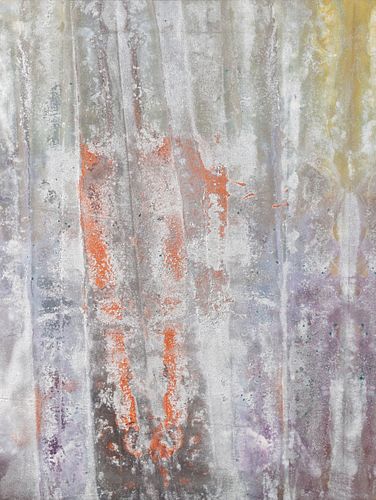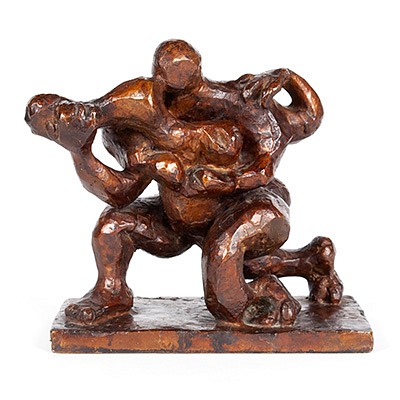SAM GILLIAM (AMERICAN, 1933-2022)
About Seller
555 Washington Ave, Ste 129
St. Louis, MO 63101
United States
Two ways to bid:
- Leave a max absentee bid and the platform will bid on your behalf up to your maximum bid during the live auction.
- Bid live during the auction and your bids will be submitted real-time to the auctioneer.
Bid Increments
| Price | Bid Increment |
|---|---|
| $0 | $5 |
| $30 | $10 |
| $100 | $25 |
| $500 | $50 |
| $1,000 | $100 |
| $3,000 | $250 |
| $5,000 | $500 |
| $10,000 | $1,000 |
| $30,000 | $2,500 |
| $50,000 | $5,000 |
| $100,000 | $10,000 |
| $300,000 | $25,000 |
| $500,000 | $50,000 |
About Auction
Jul 15, 2023
Period furniture and art entangle dramatically with modern and contemporary works. Selkirk Auctioneers & Appraisers info@selkirkauctions.com
- Lot Description
Sam Gilliam
American, 1933-2022
Orange Slice
Acrylic and aluminum dust on molded canvas
Orange, lavender, and green to the creased and paint-splattered canvas on bevel edge stretcher, titled to verso and unframed.
Lot Essay
Prepared by Bryan Laughlin, Jr., Executive Director of Selkirk Auctioneers and Appraisers
Born Samuel Gilliam, Jr. on November 30, 1933 in Tupelo, Mississippi, the young Gilliam moved with his family to Kentucky where he graduated from the University of Louisville with a BA degree, 1955. Already a skilled artist, he had his first solo exhibition that same year at the University. He later received his MFA from the University, 1961.
Gilliam himself knew he was a trail blazer of American abstraction while working in Washington, D.C. in the 1960s, during a heated national Civil Rights movement which saw segregation not only amongst the populous common but also with the elite of the art world. The racial discrimination of the time did not deter the radical and boundary pushing young artist. His paint application process, transforming of supports, inventive mediums, scholarly approach, and fortitude helped set the stage for the future of abstract painting in the United States. Associates in the acclaimed Washington D.C. 'Color Field School' included renowned artists such as Kenneth Noland, Gene Davis, Paul Reed, Alma Thomas, and Thomas Downing. Gilliam expanded the Color Field notions by insinuating the “integrity of the picture plane,” and shaking the experience of how viewers perceived visible art. During a moment when African American artists were merely expected to produce figurative work only addressing a racial-first subject matter, Gilliam instead created a new lyrical dialogue with his abstractions that heavily aided the development and evolution of non-objective art to transcend culture, race, religion, and politics.
In 1967 Gilliam created his first “Slice” series painting, which would become a series he would often return to over the course of the next few decades, manipulating canvases with rich and luminous effects on custom supports with a beveled edge. The effective intention was to remove the work from the flat surface of the wall itself and to project the vision toward the viewer in a dynamic fashion. "Orange Slice" (Lot 54) expounds upon this theory similarly to other coveted "Slice" series works held in major collections including but not limited to, "April 4, 1969" (Smithsonian American Art Museum, Washington, D.C.); "Whirlirama" 1970 (Metropolitan Museum of Art, New York); "Wide Narrow" 1972 (Rose Art Museum, Brandeis University); "Blue Twirl" 1971 (National Gallery of Art, Washington, D.C.); and "Scatter" 1972 (Indianapolis Museum of Art).
In 1972, Gilliam became the first black artist to take part in the 36th Venice Biennale’s American Pavilion curated by Walter Hopps. Concoran Gallery of Art honored his life work at the time with a retrospect in 2005. In 2015 he had the prestigious honor of receiving the United States Department of State’s first ever Medal of Arts Lifetime Achievement Award. His body of work is now celebrated in prestigious collections worldwide, including the Metropolitan Museum of Art, New York; the Museum of Modern Art, New York; the Whitney Museum of American Art, New York; The Phillips Collection, Washington D.C.; and the Tate Modern, London, amongst others. In 2017, Gilliam's work was well received and honored at the 57th Venice Biennale, considered by many to be the world's greatest convention of art and culture.
Now considered one of the greatest innovators of Post-War modern art, Sam Gilliam recently passed away June 25, 2022, at the age of 88. At the time of his death, his bold and prolific oeuvre was on display at Hirshhorn Museum, Smithsonian as part of a solo exhibition entitled: Sam Gillam: Full Circle.
42 x 32 in. (106.7 x 81.3 cm.)
The Artist,
Ex Iowa Wesleyan University collection;
Bequeathed by the Alden Lowell Doud Estate, Washington D.C.
Alden Lowell Doud (American, 1935-1912) of Iowa City, formerly of Douds, was a former First Lieutenant and Captain of the U.S. Army Judge Advocate General Corp. After serving in the military, he joined the Office of the Legal Adviser in the U.S. State Department in 1967 where he became the first Assistant Legal Adviser for Environmental Affairs. He authored the first drafts of several important environmental treaties including the World Heritage Convention. He was also a member of the U.S. delegation in the negotiations forming the International Telecommunications Satellite Consortium (INTELSAT).
In 1973, Mr. Doud joined the World Bank Legal Department as its principal administrative attorney and rose to the title of Chief Counsel until his retirement in 1996. Post retirement,
he studied at the Courtlaud Institute of Art in London and continued art studies at Bard Graduate Center in New York City.
He moved to Iowa City in 1998 and served as Chairman of Board of Trustees of Iowa Wesleyan until 2005 when he received an honorary degree Ll. D. and was made Chairman Emeritus. He was a member of University of Iowa President's Club, the Members Council of the University Museum of Art, the Harvard Club of New York City, and other arts related organizations.Condition
Any condition statement is given as a courtesy to a client, is an opinion, and should not be treated as a statement of fact. Reference to condition written, oral or within a condition report shall not be regarded as a full account of condition and may not include all defects, alterations, or restorations. Absence of a condition report does not imply a lot is flawless or lacking imperfections or damage. Selkirk Auctioneers & Appraisers shall have no responsibility for any error or omission. Returns shall not be accepted on the basis of condition.
- Shipping Info
-
The buyer is responsible for arranging pick-up and shipment of all purchased lots. All registered bidders are responsible for obtaining quotes through in-house shipping or a third-party shipping agent, in advance of bidding. A list of third-party shippers is made available on Selkirk’s website, as well as at the time of invoicing. Not all items are eligible for in-house shipping. Selkirk will not be responsible for any loss, damage, theft, or otherwise responsible for any items left in Selkirk’s possession ten (10) days after the sale. If arrangements for shipping have not been made and communicated within thirty (30) days, Selkirk reserves the right, at this time, to charge a storage fee of $10 per lot per day for furniture and large format items and $5 per lot per day for all other items, and within sixty (60) days, at its own discretion, sell any items left on the premises. Accumulated fees resulting from storage and insurance cost will be taken out of any proceeds. Objects that contain materials of endangered or protected species may be subject to regulations disallowing export and import into other states or countries. It is the buyer’s responsibility to be aware of all applicable laws and regulations and to obtain any required export or import licenses or certificates and any other required documentation. Disputes arising from damage incurred during in-house shipping are subject to the terms and conditions of filing a shipping insurance claim and of no guarantee.
-
- Buyer's Premium



 EUR
EUR CAD
CAD AUD
AUD GBP
GBP MXN
MXN HKD
HKD CNY
CNY MYR
MYR SEK
SEK SGD
SGD CHF
CHF THB
THB






















